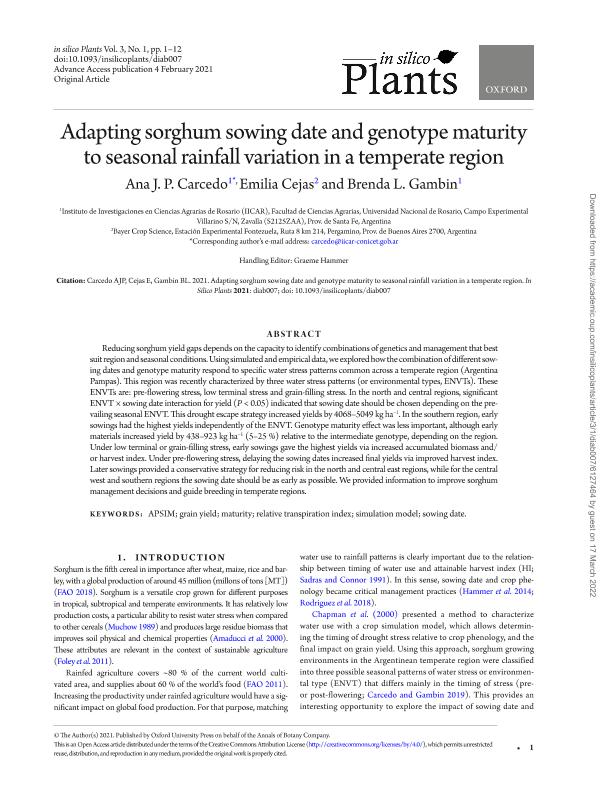Artículo
Adapting sorghum sowing date and genotype maturity to seasonal rainfall variation in a temperate region
Fecha de publicación:
02/2021
Editorial:
Oxford University Press
Revista:
In Silico Plants
ISSN:
2517-5025
Idioma:
Inglés
Tipo de recurso:
Artículo publicado
Clasificación temática:
Resumen
Reducing sorghum yield gaps depends on the capacity to identify combinations of genetics and management that best suit region and seasonal conditions. Using simulated and empirical data, we explored how the combination of different sowing dates and genotype maturity respond to specific water stress patterns common across a temperate region (Argentina Pampas). This region was recently characterized by three water stress patterns (or environmental types, ENVTs). These ENVTs are: pre-flowering stress, low terminal stress and grain-filling stress. In the north and central regions, significant ENVT × sowing date interaction for yield (P < 0.05) indicated that sowing date should be chosen depending on the prevailing seasonal ENVT. This drought escape strategy increased yields by 4068-5049 kg ha-1. In the southern region, early sowings had the highest yields independently of the ENVT. Genotype maturity effect was less important, although early materials increased yield by 438-923 kg ha-1 (5-25 %) relative to the intermediate genotype, depending on the region. Under low terminal or grain-filling stress, early sowings gave the highest yields via increased accumulated biomass and/or harvest index. Under pre-flowering stress, delaying the sowing dates increased final yields via improved harvest index. Later sowings provided a conservative strategy for reducing risk in the north and central east regions, while for the central west and southern regions the sowing date should be as early as possible. We provided information to improve sorghum management decisions and guide breeding in temperate regions.
Archivos asociados
Licencia
Identificadores
Colecciones
Articulos(IICAR)
Articulos de INST. DE INVESTIGACIONES EN CIENCIAS AGRARIAS DE ROSARIO
Articulos de INST. DE INVESTIGACIONES EN CIENCIAS AGRARIAS DE ROSARIO
Citación
Carcedo, Ana Julia Paula; Cejas, Emilia; Gambin, Brenda Laura; Adapting sorghum sowing date and genotype maturity to seasonal rainfall variation in a temperate region; Oxford University Press; In Silico Plants; 3; 1; 2-2021; 1-12
Compartir
Altmétricas




